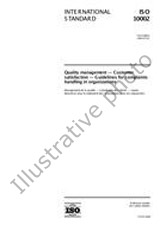We need your consent to use the individual data so that you can see information about your interests, among other things. Click "OK" to give your consent.

ISO/TS 10303-1618:2006
Industrial automation systems and integration — Product data representation and exchange — Part 1618: Application module: AP210 interconnect design for microwave
Translate name
STANDARD published on 13.12.2006
| Availability | IN STOCK |
| Price | ONREQUEST excl. VAT |
| ON REQUEST |
The information about the standard:
Designation standards: ISO/TS 10303-1618:2006
Publication date standards: 13.12.2006
SKU: NS-943467
Approximate weight : 300 g (0.66 lbs)
Country: International technical standard
Category: Technical standards ISO
The category - similar standards:
Annotation of standard text ISO/TS 10303-1618:2006 :
Description / Abstract: ISO/TS 10303-1618:2006 specifies the application module for AP210 interconnect design for microwave. ISO/TS 10303-1618:2006 deals with the representation of interconnect design for microwave. The circuit traces may be considered to be microstrip or stripline, with a specified shape element of the cross-section (i.e. point, edge, cutting plane) acting as the terminal or port of the line or component. Use of formal external definitions is provided to link in models with the product definition data. Analytical model terminals may be typed as having distributed parameters. This data identifies those elements that do not meet design requirements. This data includes both design view and usage view of the interconnect product. This data provides functional and physical layout information sufficient to allow manufacture and test of an interconnect. Design re-use is explicitly supported with traceability. Complete traceability back to requirements is provided. Product connection requirements, shape requirements, product specifications, process specifications, material specifications including manufacturing view of stackup, geometric dimensioning and tolerancing are provided. This data identifies those elements that do not meet design requirements. This data includes both design view and usage view of the interconnect product. Support for specification of signal prioritization is provided. Support for specifying the explicit network topology to be implemented is provided. Configuration management information and design change management information is provided. This data includes at least one geometric representation. The following are within the scope of ISO/TS 10303-1618:2006: two dimensional layered interconnect substrate; configuration management data; design management data; three dimensional layered interconnect substrate; three dimensional molded interconnect substrate; material conductivity classification; as-routed connections; embedded components; test points; tolerance based cutout design; tolerance based cavity design; as-required connections; partially routed connections; pre-defined printed templates for design re-use; geometric properties for trace layout; geometric properties for pad taper layout; explicit definition of terminals of the interconnect substrate; explicit definition of cavities and cutouts of the interconnect substrate required for components; mapping between the explicit definition of terminals and internal design features; printed template definitions with terminals defined with a point on a surface; printed template definitions with terminals defined using boundary element method; printed template definitions with terminals defined with an edge; printed template definitions with terminals defined with a cross-section area.
We recommend:
Technical standards updating
Do you want to make sure you use only the valid technical standards?
We can offer you a solution which will provide you a monthly overview concerning the updating of standards which you use.
Would you like to know more? Look at this page.



 Cookies
Cookies
